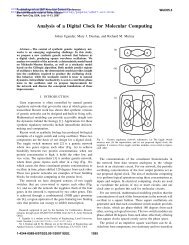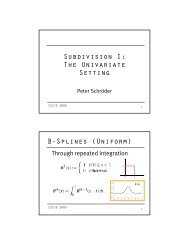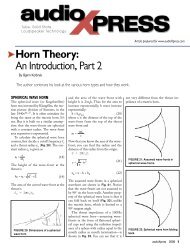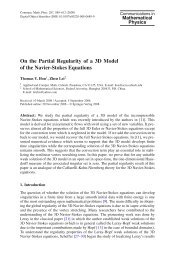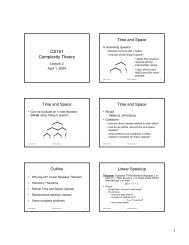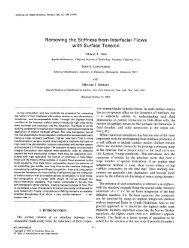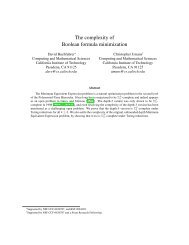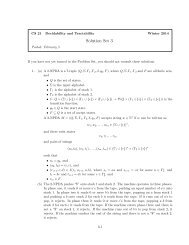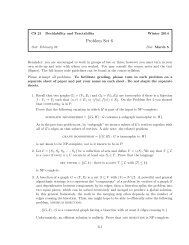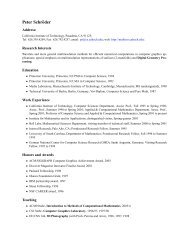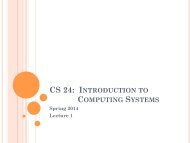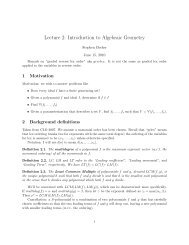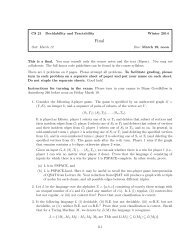From Steiner formulas for cones to concentration of intrinsic volumes
From Steiner formulas for cones to concentration of intrinsic volumes
From Steiner formulas for cones to concentration of intrinsic volumes
You also want an ePaper? Increase the reach of your titles
YUMPU automatically turns print PDFs into web optimized ePapers that Google loves.
STEINER FORMULAS FOR CONES AND INTRINSIC VOLUMES 9We follow the argument from [BLM03, Thm. 5]. Divide the inequality (4.9) by the positive number ξ 2 m(ξ)<strong>to</strong> reach1ξ · m′ (ξ)m(ξ) − 1 ξ 2 logm(ξ) ≤ 2 · m′ (ξ)m(ξ) + 2δ(C) <strong>for</strong> ξ ∈ (−∞,0) ∪ ( 0, 1 )2 .The left- and right-hand sides <strong>of</strong> this relation are exactly integrable:[ ]d 1ds s logm(s) ≤ 2 · d [ ]logm(s) + 2δ(C) · s <strong>for</strong> s ∈ (−∞,0) ∪ ( 0, 1 )ds2 . (4.10)To continue, we first consider the case 0 < ξ < 1 2. Integrate the inequality (4.10) over the interval s ∈ [0,ξ]using the boundary conditions logm(0) = 0 and lim ξ→0 ξ −1 logm(ξ) = 0. This step yields1ξ logm(ξ) ≤ 2logm(ξ) + 2δ(C) · ξ <strong>for</strong> 0 < ξ < 1 2 .Solve this relation <strong>for</strong> the moment generating function m <strong>to</strong> obtain the bound( 2ξ 2 )δ(C)m(ξ) ≤ exp<strong>for</strong> 0 ≤ ξ < 11 − 2ξ2 . (4.11)The boundary case ξ = 0 follows from a direct calculation. Next, we address the situation where ξ < 0.Integrating (4.10) over the interval [ξ,0], we find that− 1 logm(ξ) ≤ −2logm(ξ) − 2δ(C) · ξ <strong>for</strong> ξ < 0.ξSolve this inequality <strong>for</strong> m <strong>to</strong> see that the bound (4.11) also holds in the range ξ < 0. This observationcompletes the pro<strong>of</strong>.□With Lemma 4.9 at hand, we quickly reach Theorem 4.8.Pro<strong>of</strong> <strong>of</strong> Theorem 4.8. We begin with the statement from Proposition 4.6. Adding and subtracting multiples <strong>of</strong>δ(C) in the exponent, we obtain the relationEe ζ(V C −δ(C)) = e (ξ−ζ)δ(C) · Ee ξ(‖Π C (g )‖ 2 −δ(C)) .where ξ = 1 (2 1 − e−2ζ ) < 1 2. Lemma 4.9 controls the moment generating function on the right-hand side:(Ee ζ(V C 2ξ −δ(C)) ≤ e (ξ−ζ)δ(C) 2 )δ(C)· exp .1 − 2ξBy a marvelous coincidence, the terms in the exponent collapse in<strong>to</strong> a compact <strong>for</strong>m:ξ − ζ +2ξ21 − 2ξ = e2ζ − 2ζ − 1.2Combine the last two displays <strong>to</strong> finish the pro<strong>of</strong> <strong>of</strong> (4.6). To obtain the second <strong>for</strong>mula (4.7), note thatEe ζ(V C −δ(C)) = Ee (−ζ)(V C ◦ −δ(C ◦ ))because V C ∼ d −V C ◦ and δ(C) = d − δ(C ◦ ). Now apply (4.6) <strong>to</strong> the right-hand side.□4.7. Concentration <strong>of</strong> <strong>intrinsic</strong> <strong>volumes</strong>. The exponential moment bound from Theorem 4.8 allows us <strong>to</strong>obtain <strong>concentration</strong> results <strong>for</strong> the sequence <strong>of</strong> <strong>intrinsic</strong> <strong>volumes</strong> <strong>of</strong> a convex cone. The following corollaryprovides Bennett-type inequalities <strong>for</strong> the <strong>intrinsic</strong> volume random variable.Corollary 4.10 (Concentration <strong>of</strong> the <strong>intrinsic</strong> volume random variable). Let C ∈ C d be a closed convex cone.For each λ ≥ 0, the <strong>intrinsic</strong> volume random variable V C satisfies the upper tail boundP { V C − δ(C) ≥ λ } ≤ exp(− 1 { ( ) ( )})λ−λ2 max δ(C) · ψ , δ(C ◦ ) · ψδ(C)δ(C ◦ (4.12))and the lower tail boundP { V C − δ(C) ≤ −λ } ≤ exp(− 1 { ( ) (−λ2 max δ(C) · ψ , δ(C ◦ ) · ψδ(C)The function ψ(u) := (1 + u)log(1 + u) − u <strong>for</strong> u ≥ −1 while ψ(u) = ∞ <strong>for</strong> u < −1.λδ(C ◦ ))}). (4.13)



